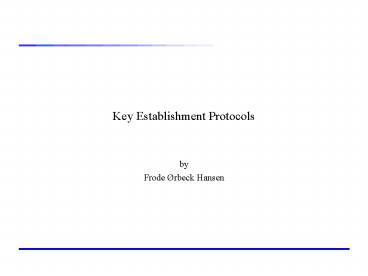Key Establishment Protocols PowerPoint PPT Presentation
1 / 15
Title: Key Establishment Protocols
1
Key Establishment Protocols
- by
- Frode Ørbeck Hansen
2
Suggested reading
- Chapter 12 (p489-p542) in Handbook of Applied
Cryptography (A. Menezes, P. van Oorschot, and S.
Vanstone, CRC Press, 1996.) - Chapter 8 (p258-p281) in Cryptography Theory and
Practice (D. Stinson, CRC Press, 1995) - Key Management Standards http//csrc.nist.gov/encr
yption/kms/
3
Contents in Brief
- Classification and framework
- Key transport based on symmetric encryption
- Key agreement based on symmetric techniques
- Key transport based on public-key encryption
- Key agreement based on asymmetric techniques
- Secret Sharing
- Conference Keying
- Analysis of Key Establishment Protocols
4
Classification and framework
- Key establishment a shared secret becomes
available to two or more parties, for subsequent
cryptographic use. - Key transport protocol
- one party creates, and securely transfers a
secret value to the other (s) - Key agreement protocol
- a shared secret is derived by two (or more)
parties as a function of information that is
exchanged between the parties involved
5
Classification and framework
- Key pre-distribution scheme
- established keys are completely determined a
priori by initial keying material - Dynamic key establishment scheme
- established keys varies on subsequent execution
- immune to known-key attack
- Trusted servers
- trusted third party, trusted server,
authentication server, key distribution
center(KDC), key translation center (KTC),
certification authority (CA) - ? for initial system setup and/or on-line actions
6
Classification and framework
- (implicit) Key authentication
- one party is assured that no other party aside
from a identified second party may gain access to
a secret key - independent of the actual possession of such key
by the second party, or knowledge of such actual
possession by the first party - Key confirmation
- one party is assured that a second party actually
has possession of a particular secret key
7
Classification and framework
- Explicit key authentication
- implicit key authentication key confirmation
- Session key
- ephemeral secret
- motivations
- to limit available cipher text attack
- to limit exposure
- to avoid long-term storage of secret keys
- to create independence across sessions or
applications
8
Contents
- Classification and framework
- Key transport based on symmetric encryption
- Key agreement based on symmetric techniques
- Key transport based on public-key encryption
- Key agreement based on asymmetric techniques
- Secret Sharing
- Conference Keying
- Analysis of Key Establishment Protocols
9
Key transport based on sym. encryption
10
Symmetric key transport and derivation without a
server
- Sharing of a long-term secret or not
- (i) Point to point key update based on key
transport (share a priori key) - A ? B EK(rA, tA, B) (one pass)
- rA session key
- Dont offer perfect forward secrecy
- If the long-term K is compromised the above
protocol fails completely - (ii) Point to point key update by key derivation
(share a priori key) - The derived session key is based on per-session
random input provided by one party - A? B rA (session key EK(rA))
- (iii) Key transport without a priori shared keys
- Key establishment over an open channel without
shared or public keys
Prevent message replay attacks
Key freshness
11
Kerberos and related server-based protocols
- The entities share a long term pairwise secret
with the server - The server plays the role of a KDC or KTC
- Needham-Schroeder protocol (historical
importance) - Basis protocol for several other server related
protocols (e.g. Kerberos) - Entity authentication (A to B)
- Key establishment with key confirmation
- Protocol Messages
- A?T A, B, NA (1)
- A?T EKAT (NA, B, k, EKBT (k, A)) (2)
- A?B EKBT (k, A) (3) (A can
securely cache this data if re-use of k is
acceptable) - A?B Ek (NB) (4)
- A?B Ek (NB - 1) (5)
- REMARK B has no way of knowing if the key k is
fresh ? if k is compromised, any party knowing it
may resend message (3) and compute message (5).
This particular situation is improved in the
Kerberos protocol by a lifetime parameter that
limits exposure to a fixed time interval.
Entity authentication
12
Kerberos and related server-based protocols
- Kerberos authentication protocol
- Client A interact with trusted server T and
verifier B - Entity authentication of A to B (optionally
mutual) - Protocol Messages
- A?T A, B, NA (1)
- A?T EKBT (k, A, L), EKAT (k, NA, L, B) (2)
- A?B EKBT (k, A, L), Ek (A, TA, Asubkey) (3)
- A?B Ek (TA, Bsubkey) (4) (Optional for
mutual authentication) - NA nonce chosen by A
- TA time stamp
- k session key chosen by T
- L lifetime
13
Contents
- Classification and framework
- Key transport based on symmetric encryption
- Key agreement based on symmetric techniques
- Key transport based on public-key encryption
- Key agreement based on asymmetric techniques
- Secret Sharing
- Conference Keying
- Analysis of Key Establishment Protocols
14
Key agreement based on sym. technique
- Key distribution system(KDS)
- a method whereby a trusted server generates and
distributes secret data values to users - key pre-distribution scheme
- unconditional security(perfect security)
- large amount of storage required (n2 - problem)
- k-secure KDS
- if any coalition of k or fewer users can do no
better at computing the key shared by the two
than a party which guesses the key without any
pieces - unconditionally secure against size k or smaller
15
Key agreement based on sym. technique
- Bloms scheme
- Each user is assigned a vector of initial secret
keying material ? compute a pair wise secret key
KU,V KV,U - Example
- OHP

